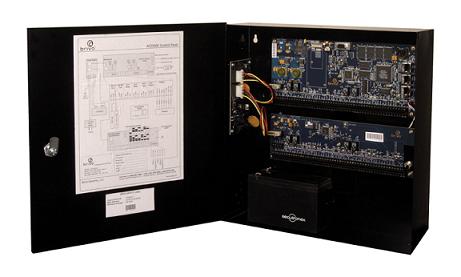|
But that isnt where Brivo started. The companys story covers the familiar ground of a promising dot-com start-up with big ideas, takes a major turn, and then ultimately shows the value of being able to take a great technology and reinvent a company in response to market conditions and even bigger opportunities.
Addressing Sticky Problems
Brivo Systems was incorporated in 1999 as Mental Physics, Inc. to provide a solution to the well-known problem of "unattended delivery." Simply stated, the problem was how to provide a secure and verifiable means for one person to deliver a package to another --specifically when the receiving party is not present at the delivery address.
For consumers, the unattended delivery issue was the so-called "yellow sticky" problem: when FedEx, UPS, or the Postal Service leaves a yellow sticky note on the door because no one is there to sign for a package. This event usually repeats itself for several days until the carrier runs out of delivery attempts, and returns the package to the depot where the consumer must pick it up or, even worse, returns it all the way to the original merchant, who must then cancel the consumers original order as undeliverable. In this situation, all parties to the transaction -- buyer, carrier, and merchant -- end up losing out: the buyer never gets his product; the carrier wastes fuel and labor without ever succeeding in a delivery; and the merchant ends up with a cancelled sale and an unhappy customer.
In 1999, it was clear that this problem was only going to get worse because of the dramatic rise in e-commerce. The firms solution was a brand new type of product: the SmartBox. It combined a secure enclosure, wireless communications, and a Web application to manage transactions between merchants, carriers, and consumers. Consumers would purchase the product from a major store, and then activate the Web and wireless services associated with it through Brivos website, much like the current practice with cellular telephones.
The company began manufacturing SmartBoxes and placing them in the market right around the time that the "Internet bubble" and the stock market generally began to decline, resulting in a decreasing consumer demand for such high-end, high-tech products. This was a case of a great idea with unfortunate timing.
Reinvention, A Survival Kit
In 2001, faced with the uncertain prospect of continuing with a risky new product or looking for alternative ways to use its technology and expertise, Brivo chose the latter. The company began searching for new market applications for its core competencies in product design, wireless communications, and Web application development. The access control field became an obvious choice due to the similarity of the applications -- both are centered on physical security controlled by an electronic credential -- and what Brivo considered to be a strong opportunity for a new technology (Internet-based applications) and a new business model (Application Service Provider) within a very traditional competitive environment.
With this new vision, Brivo reinvented itself during 2001. The core hardware components of the SmartBox were modified to fit the smaller design of a standard control panel, while the inputs and outputs were redesigned to conform to industry standards for proximity readers, door latches, motion sensors, and biometric devices. Similarly, the GUI for the online Web application was changed to meet the needs of security directors and property managers. In January 2002, Brivo formally announced its entry into the access control market, leaving the SmartBox behind as one more piece of dot-com history.
A Shift to Access Control
|

|
|
Smart Box
(Photo by Brivo) |
Brivo entered the access control market with the ACS3000 control panel, a wide-area network product that reused that same core processor and radio technology from the SmartBox era. Besides being the first control panel in the industry to be managed from a hosted Web site, it was also the first to provide dealers and installers with a built-in means of accessing remote facilities that were not served by broadband, telephony, or other telecommunications services. In the next three years, the company rapidly innovated and produced two additional versions of the Brivo control panel, culminating in the 2005 release of the ACS5000, which offers multiple connectivity options from Ethernet to GSM to CDMA.
What was unique about the new product portfolio, a direct line from Brivos SmartBox legacy, is that the servers and software are centrally located at a secure data center maintained by the firms operations staff. End users need only a browser to effectively manage the access control applications on these servers, using their own computing infrastructure. Paul Petrenko, Facilities Manager for The Village of Hoffman Estates, talks about his Brivo experience, "I often access the system from my home office and even while Im on vacation by my handheld. No matter where I am, I can be in control. I can even unlock a door or gate for a vendor from hundreds of miles away."
|

|
|
ACS On-Site product ACS5KEBox (Photo by Brivo) |
This architecture -- one of the most significant innovations in access control in twenty years -- suddenly made it possible for small and medium-sized businesses to enjoy benefits previously affordable only by the largest companies. For example, in order to serve a customer with multiple, dispersed facilities, a traditional system would have required a server at each location, with all the network engineering of routing paths, firewalls, and VPNs between them, in order to link them together into one coherent security system. With Brivo all of the network engineering is already "built in" to the product, so that even an installer with little or no IP experience can bring all the control panels online at multiple locations with a simple Web interface.
In addition to ease of use, the suppliers architecture has proven effective at reducing up-front installation costs, as well as the total cost of system ownership as compared with server- or PC-based systems. The company gains tremendous efficiencies of scale by spreading the cost of server technology over a large customer base, rather than forcing each user to maintain their own.
Wholesale Services
Due to the service-oriented nature of providing an online system with built-in telecommunications services, another element of the original business structure that Brivo retained is the concept of recurring monthly revenue.
Initially, when Brivo first entered the access control market, the company envisioned a set of relationships between vendors and customers similar to those of the consumer cell phone market. Specifically, the firm had intended to offer its hardware products as a wholesaler to dealers, who would then install and service them at the retail level for individual customers. For the monthly service component, or subscription, Brivo had planned for end-users to sign up directly with the company and pay monthly fees to Brivo -- again, just like the typical arrangements found in consumer cellular sales.
What Brivo quickly discovered, however, is that the dealers in the access control industry preferred to maintain a single financial relationship between themselves and the end-user. The company adapted to the market again by changing its business model to include wholesaling (rather than retailing) of the monthly subscription service -- in addition to the hardware -- via the dealers themselves. In this new model, end-users make all payments to their familiar dealers, while those dealers in turn purchase both hardware and the subscription Web service from Brivo at a wholesale price. This way, Brivo has no direct financial relationship with end-users, and does all of its business -- both hardware and service -- through its dealer, integrator, and distributor channels.
Powered by Brivo
Besides keeping all of the financial relationships aligned, this shift to uniformly wholesaling both product and services provided the end-user with a clear single-point relationship with their dealer for all service-related issues. It also provided the dealer with a means to create additional value for the end-user by providing account administration and technical support services through Brivos Web interface. These advantages together create a unique opportunity for integrators to better serve their customers.
The company offers these services to dealers and integrators through its "Powered by Brivo" private labeling program. This incentive package for larger dealers permits them to control nearly a dozen branding and identity elements in the user interface, from the appearance of banners to privacy statements to contact information for customer and technical support. Dealers are thus able to offer all the benefits of hosted access control without having to develop it themselves or build out the IT infrastructure needed to support it.
Constant Innovation
By constantly adapting to the market environment -- both end user and distribution --Brivo has established a reputation as a technology leader and created new ways of doing business, while making a lot of friends within the dealer and integrator communities. Starting with a great idea built on a unique, advanced architecture, the company has been able to constantly innovate to develop a portfolio of products that predicted an IP-based security industry years in advance. As that IP-based industry continues to grow in surprising and exciting ways, Brivo will continue to listen to their customers, dealers, and integrators always looking for the next big leap, the next opportunity.
|
Interview-Steven Van Till, CEO, Brivo Systems
 Brivo focuses on our own competitive advantages, and anticipates where the industry is going" Brivo focuses on our own competitive advantages, and anticipates where the industry is going"
Brivo Systems is a security systems provider for organizations that need to protect buildings and facilities. In spite of its relatively short history, Brivo already has won recognition as a global leader in access control with its cutting-edge technology of Brivoⓡ econtrol Online Access ControlTM System (ACS) which enables businesses to control physical access to offices, warehouses, or sensitive areas, where real-time control and accountability of entry are important. Steve Van Till, CEO of Brivo, reveals the story behind the firms success in the interview with Sunny Kim, Editor of Security World Intl.
Could you tell us some of the competitive edges that differentiate Brivo services and products from its competitors?
Brivos biggest competitive edge in the market is the power and ease-of-use that result from our Web-hosted system architecture. This solution provides enterprise-class, multi-site performance with even lower costs than traditional single-site systems. No other access control vendor currently offers that combination, so we enjoy a substantial competitive advantage.
According to your understanding, how are customer needs for access control changing?
More than anything else, customers need integration among all of the components of their security and access control systems. Thats why Brivo has provided integration with several brands of DVRs and we have developed an open XML API that customers and integrators can use for any custom integration they want to fit their specific security needs.
Please introduce your management philosophy to us. What could be the driving force that made the company one of the big security names?
Brivos management approach has been to focus on our own competitive advantages, and to anticipate where the industry is going. With our initial roots in a consumer electronics product, we stressed ease of use and ease of installation from the very beginning. Those important advantages flowed from our unique Web architecture. After making the transition to the access control industry, we found that those same principles have helped us close deals and achieve a leadership position. Similarly, knowing that broadband IP solutions would become the norm in security, we broadened beyond our original wireless product base to create an offering that took advantage of the economies of broadband even before it became so widespread. That meant that we were ready for the market when it arrived.
Please introduce your current sales networks around the world? And also tell us about the marketing strategy that Brivo is uniquely adopting for success.
Brivo sells through independent dealers, integrators, and national accounts throughout the United States and Canada, and we are expanding to the distribution market in Latin America and Europe with our ACS OnSite product, a stand-alone access control system for single facilities, including those housing multiple businesses.
Our "Powered by Brivo" private labeling program is a unique approach to market. This incentive package for larger dealers permits them to control nearly a dozen branding and identity elements in the user interface, from the appearance of banners to privacy statements to contact information for customer and technical support. Dealers are thus able to offer all the benefits of hosted access control without having to develop it themselves or build out the IT infrastructure needed to support it.
What do you think is the next challenge facing you?
The next challenge facing everyone in the industry is to understand the possible effects of large IT players entering the field. Given their existing brand relationship with IT departments -- who are gaining purchasing power for security products due to convergence -- we could all see a big shift toward "big name" providers of products and services over existing brands that are confined to the security space. For example, I think an interesting question is whether an IT director will feel more comfortable buying video analytics from IBM or from a security industry provider who has been in the field for a much longer period of time but doesnt have IBMs brand strength.
Last but not least, please comment on the mid- and long-term visions Brivo has now.
SVT: Our mid-term vision remains consistent with our beginnings as one of the first providers of IP-based access control, and that is to continue broadening the range of products we offer within that arena. Last year, for example, we added embedded Web server products to our existing line of Web-hosted products. This coming year will see new product introductions of a similar magnitude.
Over the long term, we see the entire security space shifting to IP devices, thus needing common management platforms and repeating the history of general purpose networking devices and network management platforms. The new challenge will be to make ones products open enough to accommodate a constantly growing set of device types, and also to understand the applications well enough to be able to manage them as part of an overall security system. |
For more info., contact to email swm@infothe.com
ⓒ2007 www.SecurityWorldMag.com. All rights reserved. |



